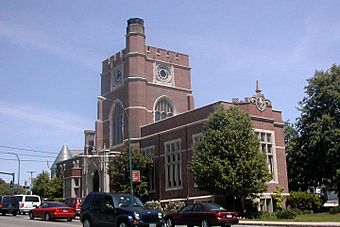Hunt Memorial Library facts for kids
|
Hunt Memorial Library
|
|
|
U.S. Historic district
Contributing property |
|
 |
|
| Location | 6 Main St., Nashua, New Hampshire |
|---|---|
| Area | 0.5 acres (0.20 ha) |
| Built | 1903 |
| Built by | Nashua Building Co. |
| Architect | Cram & Associates |
| Architectural style | Late Gothic Revival |
| Part of | Nashville Historic District (ID84000574) |
| NRHP reference No. | 71000049 |
Quick facts for kids Significant dates |
|
| Added to NRHP | June 28, 1971 |
| Designated CP | December 13, 1984 |
The Hunt Memorial Library, also known as the John M. Hunt Memorial Building, is a really old and important building in Nashua, New Hampshire. It's located at 6 Main Street in the city's downtown area. Built in 1903, this building is a great example of Gothic Revival architecture.
A famous architect named Ralph Adams Cram helped design it. He was known for bringing back the Gothic style. Even though it was once a busy library, the Nashua Public Library moved to a new spot in 1971. Today, the city owns the building. You can even rent it for special events! Because of its history and unique design, it was added to the National Register of Historic Places in 1971.
Contents
What Does the Hunt Memorial Library Look Like?
The Hunt Memorial Building stands proudly at the top of Main Street in Nashua. It's made from strong brick, laid in a special pattern called Flemish bond. This means the bricks are arranged in a way that looks very neat and strong. The building also has fancy limestone decorations.
The Impressive Tower
One of the coolest parts of the building is its tall, square tower. It has three stories and really stands out! From one corner of the tower, a small staircase turret sticks out. The tower corners are supported by strong stone structures called buttresses. These make the tower look even more grand.
The tower has big windows shaped like pointed arches, which is a classic Gothic style. At the very top, there's a clock with four faces, so you can tell the time from any direction. The top of the tower also has a crenellated parapet. This means it has a wall with gaps, like the top of a castle!
Entering the Historic Building
The main entrance to the Hunt Memorial Library is right at the bottom of the tower. You'll walk through a large, Gothic-arched doorway. The doors themselves are big and made of heavy oak wood. They even have cool designs that look like book pages carved into them!
A Look at the Building's History
This beautiful building was finished in 1903. It was one of the first big projects for the architect Ralph Adams Cram. He became very famous later in his career. Cram was actually from New Hampshire, just like this building.
The Architect's Vision
Ralph Adams Cram was a big fan of Gothic Revival architecture. This style brings back the look of old European cathedrals and castles. He spent his career making sure this style became popular again. The Hunt Building shows many of the design ideas Cram used in his work.
From Library to Event Space
For many years, the Hunt Building served as the main library for Nashua. People came here to read books and learn. But in 1971, the library moved to a new, modern building. Now, the historic Hunt Memorial Building is used for different purposes. It's a special place where people can hold events, keeping its history alive in a new way.



